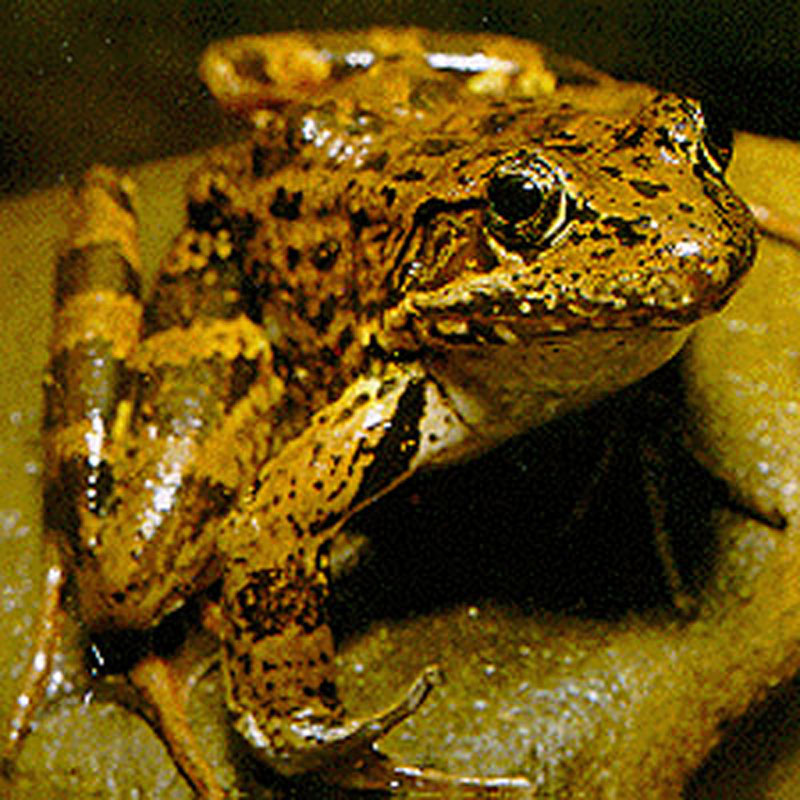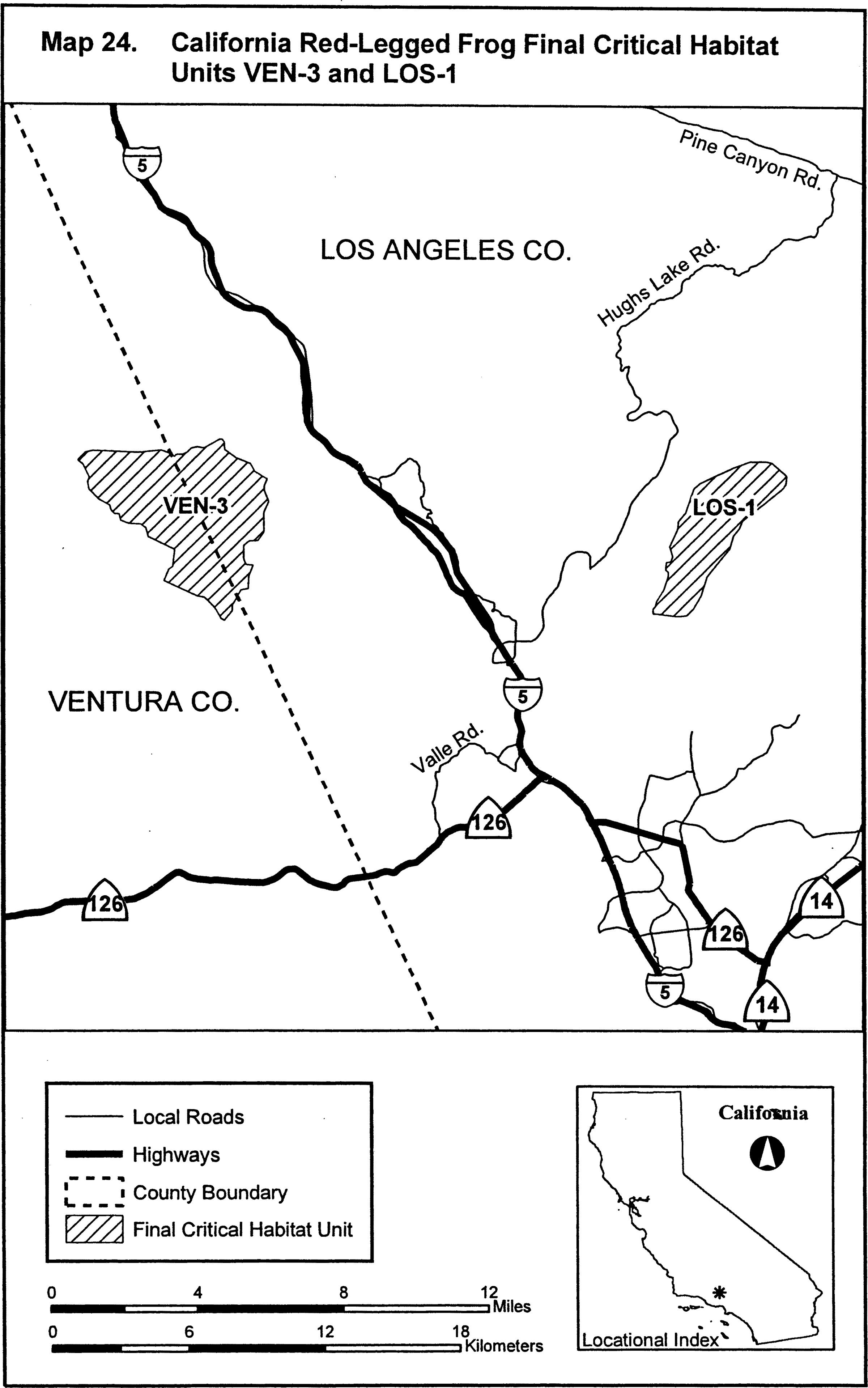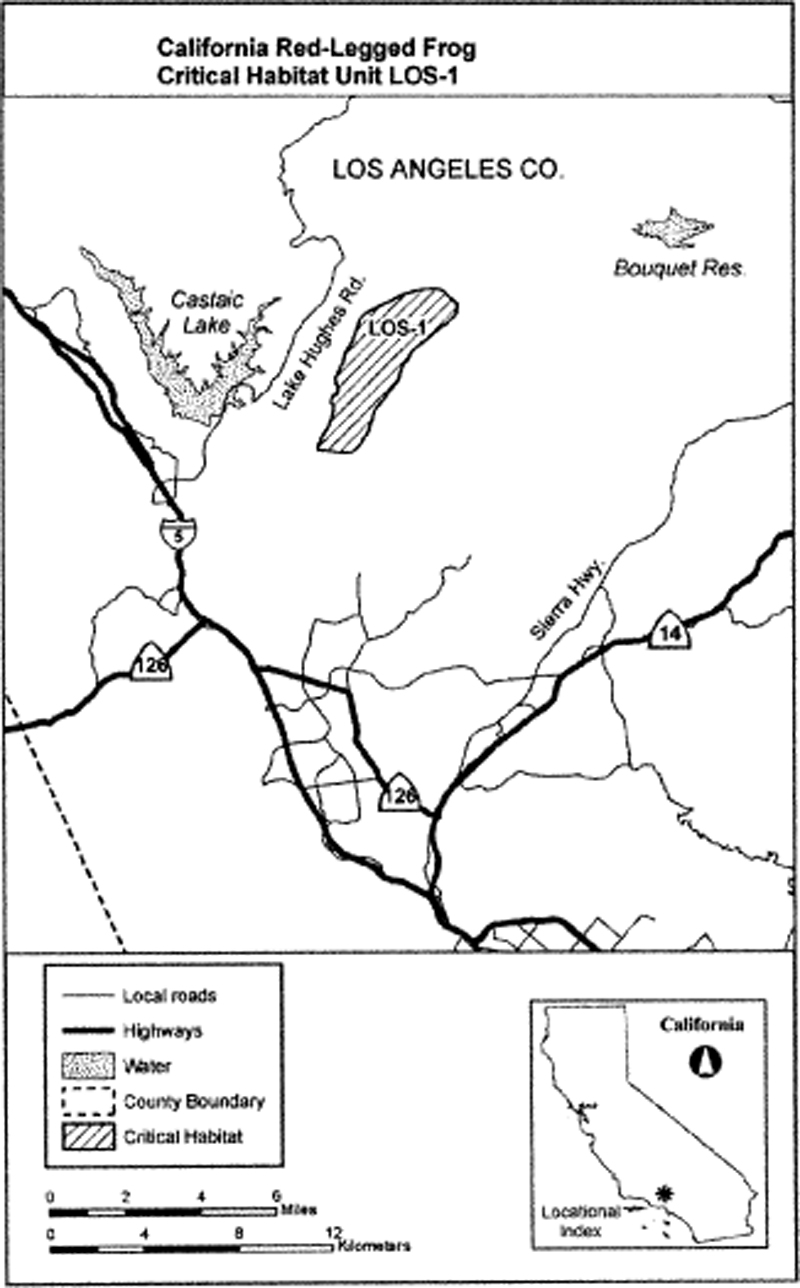|
|
|
Scientific Name: Rana aurora draytonii Status: Threatened Federal Register: 61 FR 25832 (April 23, 1996) Comments: Made famous in Mark Twain's short story, "The Celebrated Jumping Frog of Calaveras County," the California red-legged frog lives in coastal drainages from Central California to Baja. Identified in the mid-1800s, it is the largest native frog in the western United States, measuring 1.5 to 5.1 inches in length. It enjoys deep-water areas such as pools, marshes and riverbeds with dense vegetation — e.g., cattails and overhanging willows. Locally, its habitat includes the Piru Creek area, which extends from its headwaters at Frazier Mountain (near Frazier Park) southward to Lake Piru, above the town of the same name in Ventura County. The habitat extends eastward just beyond Interstate 5, northwest of Castaic Lake. Note: On June 28, 2014, California Gov. Edmund G. "Jerry" Brown signed AB 2364 (V. Manuel Perez, D-Indio), naming the California red-legged frog the official state amphibian. California previously had none. Designation of Critical Habitat for the California Red-Legged Frog
FEDERAL REGISTER We, the U.S. Fish and Wildlife Service, are designating critical habitat for the California red-legged frog (Rana aurora draytonii) pursuant to the Endangered Species Act of 1973, as amended (Act). We are further finalizing a special rule associated with final listing of the California red-legged frog as threatened for existing routine ranching activities pursuant to section 4(d) of the Act. In total, approximately 450,288 acres (ac) (182,225 hectares (ha)) fall within the boundaries of the critical habitat designation. The critical habitat is located in Alameda, Butte, Contra Costa, El Dorado, Kern, Los Angeles, Marin, Merced, Monterey, Napa, Nevada, San Benito, San Luis Obispo, San Mateo, Santa Barbara, Santa Clara, Santa Cruz, Solano, Ventura and Yuba counties, California. Los Angeles & Ventura Counties LOS-1, San Francisquito Creek (4,231 ac (1,712 ha)) This unit is located in northwestern Los Angeles County and is mapped from occurrence records at the time of listing. LOS-1 contains the following features that are essential for the conservation of the subspecies: aquatic habitat for breeding and non-breeding activities (PCE 1 and PCE 2) and upland habitat for foraging and dispersal activities (PCE 3 and PCE 4). LOS-1 contains permanent and ephemeral aquatic habitats suitable for breeding and accessible upland areas for dispersal, shelter, and food. The unit consists of private and Federal land (U.S. Forest Service). Threats that may require special management in this unit include alteration and removal of aquatic and upland habitat by residential development, degradation of habitat by recreational activities, sedimentation of aquatic habitats, conversion of native habitats by introduced invasive plants, contamination by chytrid fungus and predation by African clawed frogs (Xenopus laevis), and other nonnative species including bullfrogs and nonnative fish. VEN-1, Matilija Creek (6,660 ac (2,695 ha)) This unit is located in western Ventura County at Matilija Creek and is mapped from occurrence records at the time of listing and subsequent to the time of listing. VEN-1 contains the following features that are essential for the conservation of the subspecies: aquatic habitat for breeding and non-breeding activities (PCE 1 and PCE 2) and upland habitat for foraging and dispersal activities (PCE 3 and PCE 4). VEN-1 is occupied by the subspecies and important to the subspecies' conservation in that persistence of the subspecies in this area will prevent further isolation of breeding locations in this portion of the subspecies' range. This unit also contains permanent and ephemeral aquatic habitats suitable for breeding; contains upland areas for dispersal, shelter, and food; and is expected to prevent further fragmentation of habitat in this portion of the subspecies' range. The unit consists of private and Federal land (U.S. Forest Service). Threats that may require special management in this unit include alteration of aquatic and upland habitat by recreational activities and predation by nonnative species. VEN-2, San Antonio Creek (2,915 ac (1,180 ha)) This unit is located in western Ventura County at San Antonio Creek and is mapped from occurrence records at the time of listing and subsequent to the time of listing. VEN-2 contains the following features that are essential for the conservation of the subspecies: aquatic habitat for breeding and non-breeding activities (PCE 1 and PCE 2) and upland habitat for foraging and dispersal activities (PCE 3 and PCE 4). VEN-2 is occupied by the subspecies. Persistence of the subspecies in this area will prevent further isolation of breeding locations in this portion of the subspecies' range. This unit also contains permanent and ephemeral aquatic habitats suitable for breeding and accessible upland areas for dispersal, shelter, and food, and it is expected to prevent further fragmentation of habitat in this portion of the subspecies' range. The unit consists of private land. Threats that may require special management in this unit include alteration of aquatic and upland habitat by recreational activities, sedimentation of aquatic habitats, and predation by nonnative species. VEN-3, Piru Creek (8,837 ac (3,576 ha)) This unit is located in eastern Ventura County and northwestern Los Angeles County and is mapped from occurrence records at the time of listing at Piru Creek. VEN-3 contains the following features that are essential for the conservation of the subspecies: aquatic habitat for breeding and non-breeding activities (PCE 1 and PCE 2) and upland habitat for foraging and dispersal activities (PCE 3 and PCE 4). VEN-3 is occupied by the subspecies. Persistence of the subspecies in this area is important to prevent further isolation of breeding locations in this portion of the subspecies' range. This unit also contains permanent and ephemeral aquatic habitats suitable for breeding and upland areas for dispersal, shelter, and food. The unit consists of private and Federal land (U.S. Forest Service). Threats that may require special management in this unit include alteration of aquatic and upland habitat by unauthorized off-road vehicle use, conversion of native habitat by introduced invasive plant species, and predation by nonnative species. VEN-4, Upper Las Virgenes Canyon Open Space Preserve Lands containing features essential to the conservation of the California red-legged frog in unit VEN-4 are excluded from the critical habitat designation under section 4(b)(2) of the Act for economic reasons (see Application of Section 3(5)(A) and 4(a)(3) and Exclusions Under Section 4(b)(2) of the Act section below).
CE00002: California Environmental Protection Agency
|
The site owner makes no assertions as to ownership of any original copyrights to digitized images. However, these images are intended for Personal or Research use only. Any other kind of use, including but not limited to commercial or scholarly publication in any medium or format, public exhibition, or use online or in a web site, may be subject to additional restrictions including but not limited to the copyrights held by parties other than the site owner. USERS ARE SOLELY RESPONSIBLE for determining the existence of such rights and for obtaining any permissions and/or paying associated fees necessary for the proposed use.





